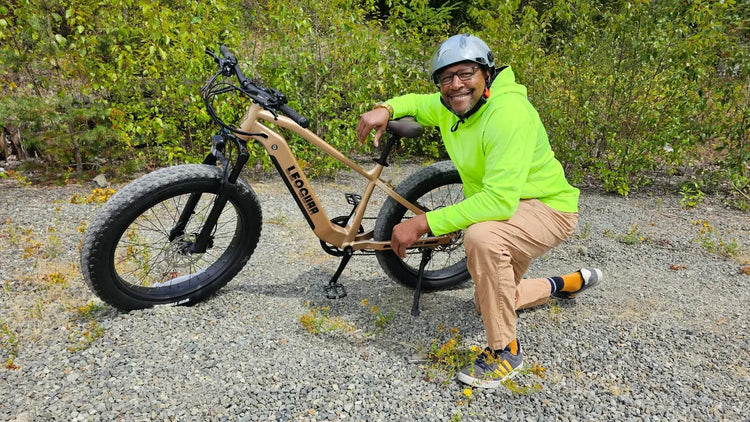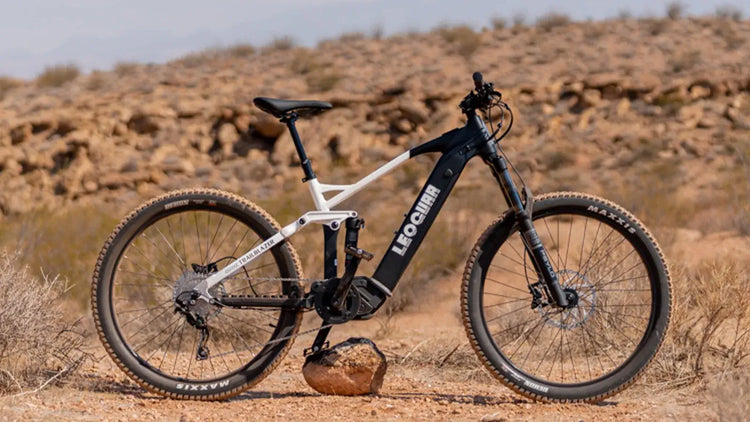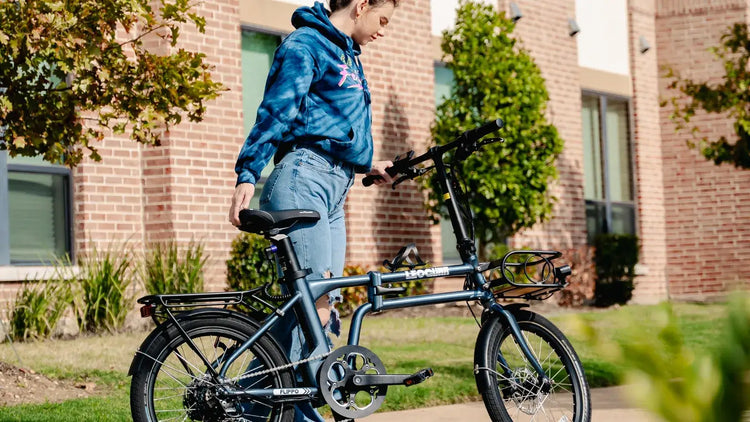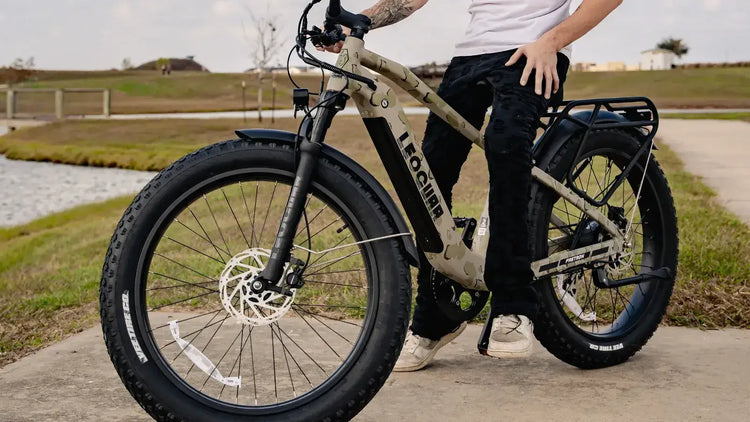
Best Racks and Covers for Storing a Hunting Electric Bike Outdoors
Introduction
Your electric hunting bike is a big investment and a special tool made for rough terrain and quiet approaches while hunting. It's more than just a way to travel; it's a key part of your hunting gear, giving you power, range, and quiet that ATVs can't offer.
When you can't store your bike inside, leaving it outside without good protection puts your investment at risk. Every owner worries about how to protect their electric hunting bikes from harsh weather and theft.
This guide addresses those concerns. We know that Hunting Electric Bikes are unique – they have strong frames, fat tires, and sensitive electrical parts. We'll look at the main dangers of outdoor storage: damage from rain and sun, wear and tear on parts, and security risks.
Most importantly, we'll show you that with the right gear, outdoor storage can work well. Getting good racks and covers made for electric hunting bikes is key to keeping your ride safe and ready for use. This article will give you all the answers you need.
Common Scenarios for Hunters
Many hunters have no choice but to store their electric hunting bike outdoors. We know that perfect indoor storage isn't always possible. Not enough indoor space is a common problem. You might live in an apartment, have a small garage, or just lack space for a large electric hunting bike.
Keeping your bike at a hunting cabin or remote property is another reason for outdoor storage. It's not always practical to transport your e-bike back and forth, so you need good outdoor storage at your hunting spot. You also need good protection during multi-day hunting trips or camping. Even short time outside can harm your bike if it's not well protected and secured. These situations show why you need the solutions we'll discuss.
Weather and Security Risks for Outdoor E-Bike Storage
When your electric hunting bike stays outside all the time, it faces two big enemies: weather and thieves. Understanding these risks helps you protect your bike better.
Weather's Impact: Rain and moisture cause rust on the frame and chain, corrosion on bolts, and can damage electrical parts like the motor, battery contacts, or display. Many electric hunting bikes have some water protection ratings, but long exposure to rain can still cause problems.
Sun and UV light also cause damage. Over time, harsh sunlight fades paint, makes plastic parts brittle, and causes tires to crack. Materials that aren't treated for UV exposure can break down quickly in constant sunlight.
Very high or low temperatures create more problems. Cold can reduce battery life, while heat can damage battery cells and electronics. Quick temperature changes cause condensation, even under a cover, leading to moisture issues.
Wind and flying debris can cause physical damage, from knocking over an unsecured bike to letting dust and dirt get into moving parts, causing faster wear.
Security Concerns: Theft of your entire electric hunting bike is a major worry. These are valuable items that attract thieves.
Even if the whole bike isn't stolen, thieves might take parts. Batteries, often the most expensive part, are targets, along with wheels, GPS units, or other removable accessories.
Vandalism, though less common, is another risk when bikes are left in accessible outdoor spots.
Police advise using quality locks and securing bikes to fixed objects to prevent theft. The high value of electric hunting bikes makes them even more attractive to thieves, so they need stronger security.
Choosing the Right Fortress: Essential Features of Outdoor E-Bike Racks
Picking the right outdoor rack for your Hunting Electric Bike is very important. It's not just about holding the bike up; it's about security, standing up to weather, and fitting your specific e-bike.
We've found that certain rack types work better for sturdy electric hunting bike storage outdoors:
| Rack Type | Pros | Cons | Best For | Typical Materials | Suitability for Heavy Electric Hunting Bikes |
| Wall-Mounted (Heavy-Duty) | Space-saving; very secure if anchored to solid wall/studs. | Requires sturdy wall; installation can be more involved. | Limited ground space; permanent storage. | Powder-coated steel | Excellent (if rated for weight) |
| Floor-Standing/Anchored | High stability; can be extremely heavy-duty; often easier to use. | Can take up more space; requires anchoring to ground for best security. | Garages, sheds, dedicated outdoor spots with concrete/solid ground. | Galvanized/powder-coated steel | Excellent |
| Shed-Internal Racks | Bike is within a shed offering an extra layer of weather protection. | Rack itself still needs to be secure; dependent on shed security. | Using a small, secure outdoor shed as the primary e-bike enclosure. | Steel, heavy-duty plastic | Good (focus on internal security) |
-
Material & Durability: We always recommend heavy-duty steel, either galvanized or powder-coated, to resist rust. Heavy-duty aluminum can work, but make sure it's strong enough. Avoid weak materials that will rust or bend easily.
-
Security: Look for places where you can attach strong U-locks or chains to secure both the rack and your bike frame, and ideally a wheel too. Tamper-resistant bolts for the rack itself are a plus. The rack should let you use multiple locks in different ways.
-
Bike Compatibility: This is critical. Your rack must hold heavy weight, since electric hunting bikes often weigh over 50-70 pounds. It must also fit wide, fat tires – look for adjustable wheel holders or enough width.
-
Ease of Installation & Use: While security is most important, the rack should have clear instructions and be fairly easy to set up and use. Think about how easy it will be to put your heavy e-bike on and take it off the rack daily.
-
Weather Resistance (for the rack itself): The rack's materials and coatings must withstand being outdoors all the time. It must be rust-proof, and any plastic parts should resist UV rays to prevent cracking and fading.
Installation Considerations:
Anchoring is key for outdoor racks. Wall-mounted racks must be attached to solid masonry, concrete, or sturdy studs – drywall anchors aren't strong enough for a heavy electric hunting bike. When we installed a heavy-duty wall anchor into concrete block, the difference in strength compared to a lighter rack was obvious. The bike felt completely secure.
Floor-standing racks should be bolted into concrete or a solid patio for best security. A rack just placed on the ground can be carried away with the bike attached, or knocked over. A well-anchored system gives great peace of mind.
The Shield Against Elements: Selecting the Perfect Outdoor E-Bike Cover
A good outdoor cover is your electric hunting bike's first defense against weather. Many people think a regular tarp will work, but that's a mistake, especially for e-bikes.
Regular tarps often don't fit well, leading to wind catching and lifting them, which can scratch paint or even pull the cover off. More importantly, they usually aren't breathable. This traps moisture underneath, creating dampness that speeds up rust and corrosion – very harmful for electrical parts. An electric hunting bike needs a cover designed just for its needs.
-
Material: We look for high-quality, heavy-duty polyester fabrics, often called Oxford fabric, with ratings like 210D, 300D, 400D, or even 600D. Denier (D) shows how thick the fibers are; higher D usually means tougher and more tear-resistant. Ripstop nylon is another great option. The material must have UV protection to prevent sun damage and a good waterproof coating (like PU - polyurethane).
-
Waterproofing & Breathability: Look for high waterproof ratings, often shown as millimeters (like 2000mm or 3000mm+). Taped seams are crucial to keep water from getting in at the stitching. However, complete waterproofing without any breathability can cause problems. Good covers have vents or use breathable materials to let trapped moisture escape, preventing mold and mildew.
-
Secure Fit: A snug, secure fit is vital. Features like strong elastic hems (front and rear), adjustable straps with buckles that go under the bike or around wheels, and drawstrings help keep the cover in place, even in strong winds. Proper sizing is crucial, especially for larger electric hunting bikes with wider handlebars, fat tires, and hunting accessories. Measure your bike carefully and check size guides.
-
Lock Holes/Slots: Reinforced holes or slots near the wheels are a must. These let you put your locks through the cover to secure the bike frame and wheels to your rack. This not only secures the bike but also locks the cover to the bike, preventing cover theft.
-
Visibility: If your electric hunting bike is stored where cars might pass, like a driveway or near a road, reflective strips on the cover improve nighttime visibility, reducing accident risks.
-
Durability: Beyond the material, look for signs of quality construction. Double-stitched seams, reinforced areas at stress points (like handlebar areas), and strong buckles all help the cover last longer.
Regular bicycle covers often won't work for electric hunting bikes. These bikes are typically longer, taller (especially with upright handlebars), and much wider due to fat tires (4 inches or more). If you have racks, gun holders, or bow carriers attached, you'll need an even larger cover. Always look for a cover made for fat tire e-bikes or ATVs if you can't find one for your exact model, and check the dimensions.
DIY & Enhanced Security Strategies for Your Outdoor-Stored Hunting E-Bike
Buying a good rack and quality cover is a great start, but for real peace of mind when storing your valuable electric hunting bike outdoors, we suggest using multiple layers of security. Many of these additions are practical, often low-cost, and can really help deter thieves.
Layering Locks: Don't rely on just one lock. Using different types of high-quality locks creates a tougher challenge. Use a main hardened steel D-lock or U-lock to secure the frame and rear wheel directly to your anchored rack. Add a heavy-duty chain lock (10mm or thicker links) to secure the front wheel and frame to the rack or another anchor point. Consider a disc brake lock with an alarm for extra protection.
Ground/Wall Anchors: The best locks won't help if a thief can simply lift your bike—rack and all—or cut through a weak post. A securely installed ground anchor (bolted into concrete) or a heavy-duty wall anchor gives you a solid point to lock your electric hunting bike to. This is essential in high-risk areas.
Concealment: "Out of sight, out of mind" is true. Always use your bike cover. If possible, place your stored electric hunting bike where it's not easily visible from the street or paths. A less obvious location makes it less tempting to thieves.
Alarm Systems & Trackers: Think about adding a bike alarm. Many activate when the bike is moved and make a loud noise. For ultimate recovery chances, a hidden GPS tracker can help you find your electric hunting bike if stolen. Some trackers also send alerts if your bike moves outside a set area.
Making it Less Attractive: If your e-bike battery is easy to remove, consider taking it inside. This makes the bike less useful and less appealing to thieves. Marking your frame with an ID system can also deter theft and help with recovery.
Environmental Deterrents: Simple environmental changes can make a big difference. Motion-sensor lights shining on the storage area can startle potential thieves. Visible security cameras (even high-quality fake ones) can also make them think twice. Thoughtful placement and visibility are key security elements.
Our complete security setup for an outdoor-stored electric hunting bike often includes: a floor-anchored steel rack, a 16mm D-lock through the frame/rear wheel to the anchor, a 12mm hardened steel chain through the front wheel/frame to another part of the anchor, a motion-sensor alarm on the bike itself, and the bike always covered. The idea is to make theft too time-consuming, too noisy, and too risky.

Proactive Maintenance for Outdoor-Stored Electric Hunting Bikes
Even with the best rack and cover, an electric hunting bike stored outdoors faces harsher conditions than one kept indoors. This means you need a more careful maintenance schedule to preserve its life, performance, and safety. Ignoring these needs can lead to expensive repairs and a shorter life for your investment.
Regular Cleaning: Outdoor storage means more exposure to dust, dirt, pollen, bird droppings, and moisture. We recommend washing more often – at least every couple of weeks, or after any particularly wet or muddy rides. This removes harmful elements and lets you inspect the bike closely.
Lubrication: The chain, derailleur, pivot points, and cables will need more frequent lubrication to prevent rust, corrosion, and ensure smooth operation. A good quality wet lube often works better for outdoor conditions but can attract more dirt, so clean before re-lubing.
Battery Care: Temperature changes significantly affect battery health and charge.
-
Extreme cold (below 32°F) can temporarily reduce range and permanently shorten lifespan if sustained.
-
Extreme heat (above 113°F) can also damage battery cells.
-
Ideal battery storage temperatures are generally between 50°F to 77°F. If your electric hunting bike battery is removable, we strongly advise bringing it indoors during periods of extreme heat or cold, even if the bike itself is covered outdoors.
Tire Checks: UV exposure can damage tire rubber over time, leading to cracks on the sidewalls. Regularly inspect tires for any signs of aging, cuts, or objects stuck in the tread. Keep proper tire pressure, as this can change more with outdoor temperature changes.
Electrical Connections: Pay close attention to electrical connection points – battery terminals, motor connections, display wiring. Check for any signs of corrosion (green or white powder). Applying a small amount of dielectric grease to these connections can help keep out moisture and prevent corrosion.
Frame and Component Inspection: On your Hunting Electric Bike frame, especially if it's steel, look for any chips in the paint that could become rust spots. On all parts, watch for early signs of rust or wear that might worsen due to outdoor conditions. This includes bolts, spokes, and brake components.
Cover Maintenance: Your bike cover also needs care. Clean it regularly according to manufacturer instructions to remove dirt and prevent mold growth. Check it for any tears or damage, and re-apply waterproofing spray if you notice it's not repelling water as well.
We use a simple checklist for our outdoor-stored e-bikes: weekly visual inspection for new rust/damage, chain lube check, tire pressure. Every two weeks: quick clean, closer inspection of electrical parts. Monthly: thorough clean, battery contact check/clean, cover inspection. This routine helps catch small issues before they become big problems.
Our Top Considerations for Racks & Covers
Choosing the right rack and cover for your electric hunting bike means balancing several factors. Instead of specific product reviews that quickly become outdated, we want to give you a framework to evaluate options based on your specific needs and environment.
For Racks: Your main focus should be on the security level needed for your area. Is your bike stored in a private backyard or a more accessible front drive? This determines how heavy-duty your anchoring and lock system needs to be. Think about available space: will a wall-mounted rack save important floor space, or do you have room for a strong floor-anchored unit? Importantly, match the rack to your specific electric hunting bikes – its weight and especially its tire width. Many standard bike racks simply won't fit the fat tires common on hunting models. Finally, consider ease of use. A super-secure rack is useless if it's too hard to get your heavy e-bike onto it every day.
For Covers: Material quality and complete weatherproofing are essential. Don't try to save money here; a cheap cover will break down quickly and offer poor protection. Look for durable, UV-resistant, and truly waterproof (not just water-resistant) fabrics with sealed seams.
Make sure it fits your Hunting Electric Bike dimensions. A loose, flapping cover won't protect well. Measure your bike with any accessories and compare to the cover's stated dimensions. Features like reinforced lock holes are not just nice extras; they are essential for your security system.
Budget vs. Protection: It's tempting to save money on storage accessories after spending a lot on an electric hunting bike. However, we believe quality racks and covers are part of that initial investment. Spending a bit more on strong, durable protection will save you much more over time by preventing weather damage, deterring theft, and extending your e-bike's life.
Conclusion
Protecting your electric hunting bike when stored outdoors is not just about keeping it looking good; it's about safeguarding a vital piece of hunting equipment and a significant financial investment. As we've shown, the threats from weather and theft are real and can quickly damage your e-bike's value and function.
A high-quality, well-chosen rack provides the secure foundation, while a durable, properly fitting cover acts as the essential shield against the elements. By understanding what features to look for in both, and by using layered security and regular maintenance, you can confidently store your Hunting Electric Bike outdoors.
In the end, investing in the right outdoor storage solutions gives you peace of mind. It ensures your electric hunting bike stays in great condition, reliable, and ready for your next hunting adventure without unexpected problems or the heartbreak of damage or loss. Assess your needs, choose wisely, and protect your ride.
FAQs
1. What are the main risks of storing electric hunting bikes outdoors?
The primary risks include weather damage (rain causing rust and corrosion, UV light degrading materials, temperature extremes affecting batteries) and security concerns (theft of the entire bike or valuable components like batteries).
2. What features should I look for in a rack for my electric hunting bike?
Look for heavy-duty steel construction (galvanized or powder-coated), multiple secure locking points, compatibility with fat tires, weight capacity over 70 pounds, and strong anchoring capabilities to walls or ground.
3. How do I choose the right cover for my electric hunting bike?
Select a cover with high-denier waterproof fabric (300D+), UV protection, breathability features to prevent condensation, secure fit with elastic hems and straps, reinforced lock holes, and dimensions that accommodate fat tires and accessories.
4. Should I remove my electric hunting bike battery when storing outdoors?
Yes, if possible. Extreme temperatures (below 32°F or above 113°F) can damage battery cells and reduce lifespan. The ideal storage temperature for e-bike batteries is between 50°F and 77°F.
5. What maintenance is required for outdoor-stored electric hunting bikes? Implement more frequent cleaning (every 2 weeks), regular lubrication of the chain and moving parts, tire pressure checks, inspection of electrical connections for corrosion, and examination of the frame for early signs of rust or damage.






































Leave a comment